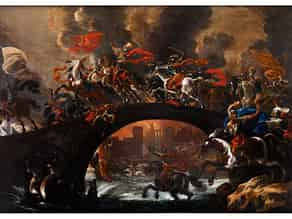Votre recherche Vincent Adriaenssen dans la vente
Tableaux du XIX - XX siècle
mercredi, 1 juillet 2015
» reset
Votre assistant d‘art personnel

Vous êtes intéressé par des œuvres de Vincent Adriaenssen?
Nous vous informons volontiers si les œuvres d‘art de Vincent Adriaenssen vendus dans une de nos prochaines vente aux enchères.
Veuillez accepter notre politique des confidentialité
705
Vincent Adriaenssen, gen. „Il Manciola“
oder „Il Mozzo di Anversa“,
1595 Antwerpen - 1675 Rom
SCHLACHTENGEMÄLDE MIT PFERDEN AUF EINER BRÜCKE Öl auf Leinwand.
121 x 170 cm.
Gerahmt.
Prix de catalogue € 12.000 - 15.000
Prix de catalogue€ 12.000 - 15.000
$ 12,960 - 16,200
£ 10,800 - 13,500
元 93,840 - 117,300
₽ 1,193,880 - 1,492,350
Vincent Adriaenssen lernte sein Handwerk in Flandern im Kreis um Rubens; später zog er nach Rom, wo er bis zu seinem Lebensende blieb und ein sehr produktiver und anerkannter Schlachtenmaler wurde. Dieses Genre war, um die Mitte des Jahrhunderts, in der ewigen Stadt sehr beliebt. Sein malerischer Ausdruck bewegt sich zwischen dem späten Cavalier d'Arpino und Tempesta, besitzt jedoch auch Anklänge an Rubens und die barocken Innovationen eines Jacques Courtois „l Borgognone“. Die lebhafte Darstellung dieser Schlacht auf der Brücke besitzt jene künstlerische, stilistische Reife, die Giancarlo Sestieri dazu bewegte, dieses Gemälde als „eines (von Adriaenssens) besten Werken überhaupt...“ zu bezeichnen. „Il Manciola bringt hier gelungen seine extrovertierte Lebhaftigkeit zum Ausdruck und stellt seine reife Meisterschaft unter Beweis“ (2004, S. 223). Weiter merkt Sestieri (2011, S. 22)an: Die Pferde und Reiter, die auf dem Gemälde in großer Zahl zu sehen sind, besäßen „Dynamik und eine ausgefallene Gestik ... als seien sie künstlich in ihrer Bewegung zum Erstarren gebracht worden“.
Literatur:
Giancarlo Sestieri, Antico e moderno nella pittura di „battaglia“. Contibuti al Manciola, a Michelangelo delle Battaglie e al Borgogonone, in: Studi sul Barocco romano. Scritti in onore dei Maurizio Fagiolo dell'Arco, Mailand, 2004, S. 219-229.
Ausstellungskatalog Rom, Giancarlo Sestieri (Hrsg.), I Battaglisti. La pittura di battaglia dal XVI al XVIII secolo, Rom, 2011, Nr. 2, S. 22-23.
Ausstellungen:
I Battaglisti. La pittura di battaglia dal XVI al XVIII secolo, Tivoli Villa d'Este, 16. Juni - 30. Oktober 2011. (10124012) (21)
Vincent Adriaenssen, also known as “il Manciola” or “il Mozzo di Anversa”,
1595 Antwerp - 1675 Rome
BATTLE SCENE WITH HORSES ON A BRIDGE
Vincent Adriaenssen learned his craftsmanship in Flanders in the circle surrounding Rubens. He later moved to Rome where he remained until the end of his life and became a very prolific and renowned painter of battle scenes. This genre was very popular in the eternal city in the middle of the century. His painterly expression ranges between the late Cavalier d’Arpino and Tempesta, but is also reminiscent of Rubens and the Baroque innovations of Jaques Courtois “il Borgognone”. The lively depiction of the battle on the bridge displays the artistic, stylistic maturity which led Giancarlo Sestieri to describe this painting as “one (of Adriaenssen’s) best works ever. Here ‘Il Manciola’ succeeds in expressing his extrovert vivacity and demonstrates his mature mastery” (2004, p. 223). Furthermore Sestieri notes that (2011, p. 22) the horses and riders, which can be seen in great numbers on the painting are “dynamic and show exceptional gestures (...) as if they have been artificially frozen in their movement”.
Literature:
Giancarlo Sestieri, Antico e moderno nella pittura di “battaglia”. Contibuti al Manciola, a Michelangelo delle Battaglie e al Borgogonone, in: “Studi sul Barocco romano. Scritti in onore dei Maurizio Fagiolo dell’Arco”, Milan, 2004, pp. 219-229.
Exhibition catalogue Rome, Giancarlo Sestieri (ed.), I Battaglisti. La pittura di battaglia dal XVI al XVIII secolo, Rome, 2011, no. 2, pp. 22-23.
Exhibitions:
I Battaglisti. La pittura di battaglia dal XVI al XVIII secolo, Tivoli Villa d’Este, 16 June - 30 October 2011.
This object has been individually compared to the information in the Art Loss Register data bank and is not registered there as stolen or missing.
Votre assistant d‘art personnel
Vous voulez être informé quand dans nos prochaines ventes aux enchères une œuvre d‘art de Vincent Adriaenssen sera proposée? Veuillez activer votre assistant d‘art personnel.
Veuillez accepter notre politique des confidentialité
Voulez-vous acheter une œuvre d‘art de Vincent Adriaenssen?
Voulez-vous acheter un objet similaire? Acheter en vente privée dates de vente aux enchères
Nos experts vous aident personnellement dans votre recherche d‘objets d‘art.
Voulez-vous vendre une œuvre d‘art de Vincent Adriaenssen?
Livrez maintenant Vente privée FAQ
Vos envois sont toujours les bienvenus. Nos experts se feront un plaisir de vous conseiller personnellement, nous nous réjouissons de votre appel.
Contactez nos experts




















